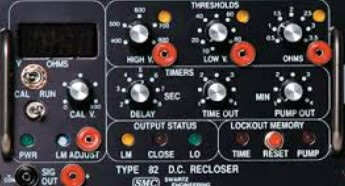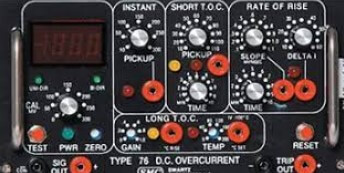
The rail industry is a backbone of transportation, supporting the movement of people and goods across vast distances with remarkable efficiency. One critical aspect of maintaining this efficiency and ensuring the safety and reliability of railway systems is the use of protection relays. At Swartz Engineering, we understand the pivotal role that protection relays play in the rail industry. In this blog post, we'll explore the intricacies of protection relays, their importance, and how they safeguard the operations of modern rail networks
Understanding Protection Relays
Protection relays are essential components in the electrical systems of railways. They are designed to detect faults or abnormalities in the electrical circuits and respond by initiating corrective actions, such as tripping circuit breakers to isolate faulty sections. This prevents damage to equipment and ensures the safety of personnel and passengers.
Protection relays monitor electrical parameters like voltage, current, and frequency. When these parameters deviate from predefined safe limits, the relays act swiftly to protect the system. The technology behind protection relays has evolved significantly over the years, from electromechanical devices to advanced digital systems.
Types of Protection Relays in the Rail Industry
1. Overcurrent Relays
Overcurrent relays are among the most commonly used protection relays in the rail industry. They are designed to detect excessive current flow in electrical circuits, which can indicate short circuits or overload conditions. When the current exceeds a preset threshold, the relay trips the circuit breaker, isolating the faulty section and preventing potential damage or hazards.
2. Distance Relays
Distance relays, also known as impedance relays, are used primarily in the protection of transmission lines. They measure the impedance between the relay and the fault location. If the impedance falls within a certain range, indicating a fault within the protected zone, the relay operates. This type of relay is crucial for protecting long-distance power lines that supply electricity to railway systems.
3. Differential Relays
Differential relays are used to protect transformers, generators, and busbars in railway substations. They compare the current entering and leaving a protected zone. Any discrepancy between these currents, indicative of a fault within the zone, triggers the relay to isolate the faulty equipment. This precise detection capability makes differential relays vital for protecting high-value assets in the rail industry.
4. Directional Relays
Directional relays determine the direction of fault current flow and are essential for complex rail networks where power can flow from multiple sources. These relays help in distinguishing between forward and reverse faults, ensuring that only the faulty section is isolated, and minimizing disruption to the rest of the network.
5. Frequency Relays
Frequency relays monitor the frequency of the electrical supply. Abnormal frequency conditions, such as overfrequency or underfrequency, can indicate generation or load imbalances. Frequency relays help in maintaining the stability of the rail network's power supply by disconnecting affected sections when necessary.

GET IN TOUCH
The ultimate solution for reliable power control! call us at 276-285-3841
The Role of Protection Relays in Railways
In the rail industry, protection relays are crucial for several reasons:
1. Safety
The primary role of protection relays is to ensure the safety of railway operations. They detect faults and isolate affected sections to prevent damage to equipment and reduce the risk of accidents. This is especially important in passenger trains, where the safety of hundreds of people is at stake.
2. Reliability
Railway systems rely on continuous and reliable power supply for operations such as signaling, communications, and propulsion. Protection relays help maintain the reliability of these systems by quickly responding to electrical faults and minimizing downtime.
3. Equipment Protection
Electrical equipment used in railway systems, such as transformers, generators, and traction motors, are valuable assets. Protection relays safeguard these assets from damage due to electrical faults, prolonging their operational life and reducing maintenance costs.
4. Operational Efficiency
By minimizing the impact of electrical faults and reducing the time needed to restore normal operations, protection relays enhance the overall efficiency of the rail network. This ensures timely and efficient movement of trains, which is critical for both passenger and freight services.
How Protection Relays Work
Protection relays operate based on a set of predefined criteria that correspond to normal and abnormal operating conditions. Here’s a step-by-step overview of how they function:
1. Monitoring
Protection relays continuously monitor electrical parameters such as current, voltage, and frequency in the system. This real-time monitoring allows them to detect any deviations from the norm.
2. Detection
When the monitored parameters exceed or fall below set thresholds, the relay detects a fault condition. For example, an overcurrent relay will detect when the current exceeds a safe limit.
3. Decision Making
Once a fault is detected, the relay evaluates the severity and location of the fault. Advanced digital relays can analyze complex conditions and differentiate between faults that require immediate action and those that do not.
4. Action
If the fault is deemed critical, the relay sends a trip signal to the circuit breaker. The circuit breaker then opens, isolating the faulty section from the rest of the network. This action prevents further damage and ensures the safety of the system.
5. Communication
Modern protection relays are often equipped with communication capabilities that allow them to relay fault information to a central control system. This helps operators to quickly identify and address issues, further enhancing the reliability of the rail network.

GET IN TOUCH
The ultimate solution for reliable power control! call us at 276-285-3841
Advancements in Protection Relay Technology
The evolution of protection relays has been marked by significant technological advancements. Swartz Engineering has been at the forefront of these developments, offering state-of-the-art solutions for the rail industry. Some key advancements include:
1. Digital Relays
Digital relays have replaced traditional electromechanical relays in many applications. They offer enhanced accuracy, faster response times, and the ability to analyze complex fault conditions. Digital relays also come with self-diagnostic features that improve reliability and reduce maintenance requirements.
2. Programmable Relays
Programmable protection relays allow for customized settings and adaptive protection schemes. This flexibility is particularly useful in the rail industry, where operating conditions can vary widely.
3. Integrated Systems
Modern protection relays are often part of integrated systems that combine protection, control, and monitoring functions. These systems provide comprehensive oversight of the electrical network and enable coordinated responses to faults.
4. Communication Capabilities
The integration of communication protocols such as IEC 61850 enables protection relays to communicate with other devices and central control systems. This facilitates real-time data sharing and enhances the ability to manage and respond to faults.
Conclusion
Protection relays are indispensable in the rail industry, playing a vital role in ensuring safety, reliability, and operational efficiency. At Swartz Engineering, we are committed to providing cutting-edge protection relay solutions that meet the demanding needs of modern railway systems. As rail networks continue to expand and evolve, the importance of robust and advanced protection relays will only grow, securing the future of rail transportation.
By understanding how protection relays work and their impact on the rail industry, we can appreciate their significance in maintaining the integrity and performance of railway systems. With continued innovation and advancements, protection relays will remain a cornerstone of safe and reliable rail operations. To learn more about the rail industry contact us today!
Our Expert Services
Swartz Engineering provides top-quality products to meet our customers' needs. We also make sure our products work reliably and safely. Our products include:
- Type 76 DC Relay
- Type 82 DC Relay
- Swartz Engineering’s Type 64 Ground Relay
- Type 32 Reverse Current Relay
- Type 150 DC
- CSM Shield Monitor
- Metal Oxide Surge Arrestors
- Transducers
- MVIS SL Slim-line Contactor
- Fully-tested Power Control Rooms
- Swartz Engineering’s Portable Substations
CONTACT US
Take the first step towards powering up your operations! call us at 276-285-3841
